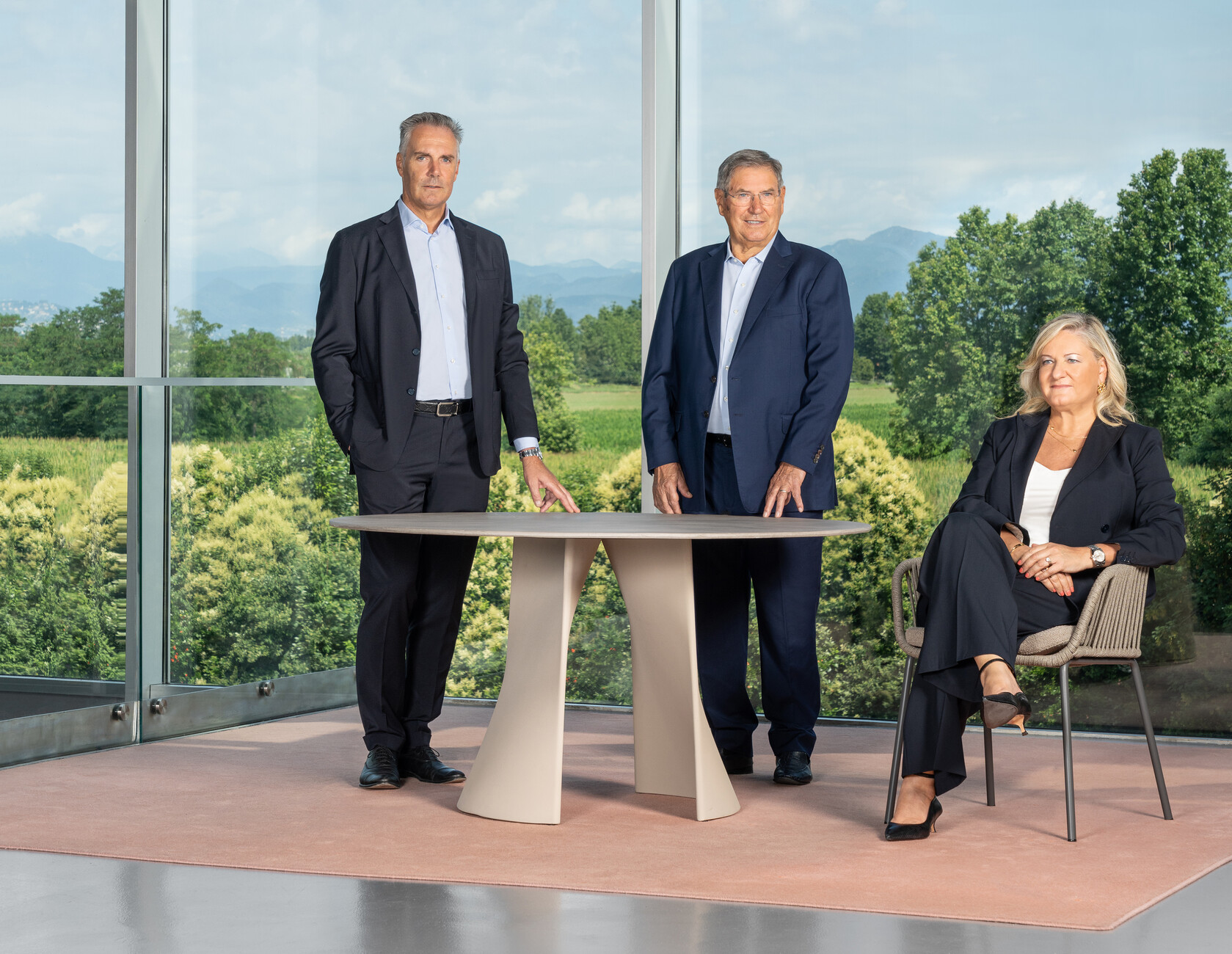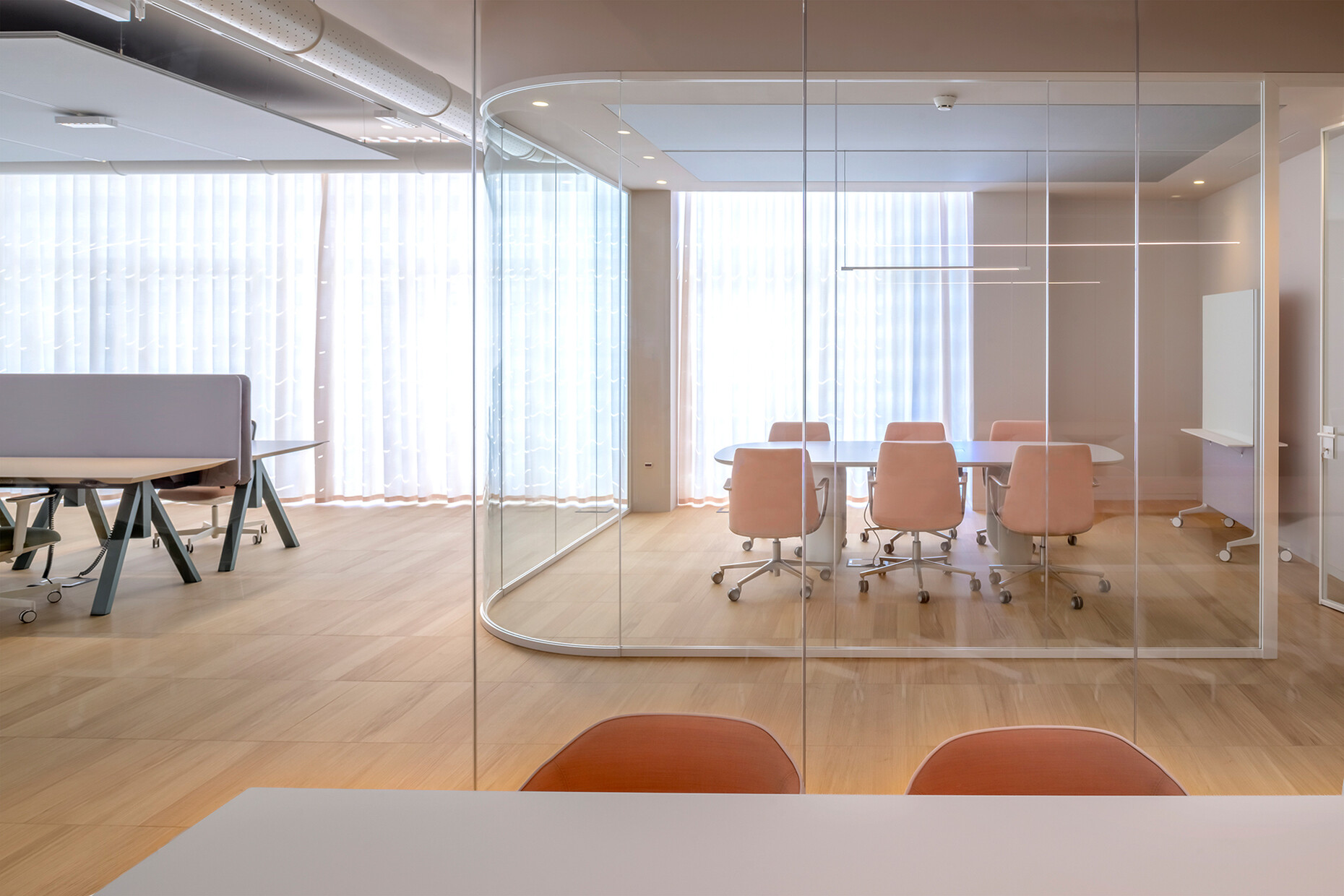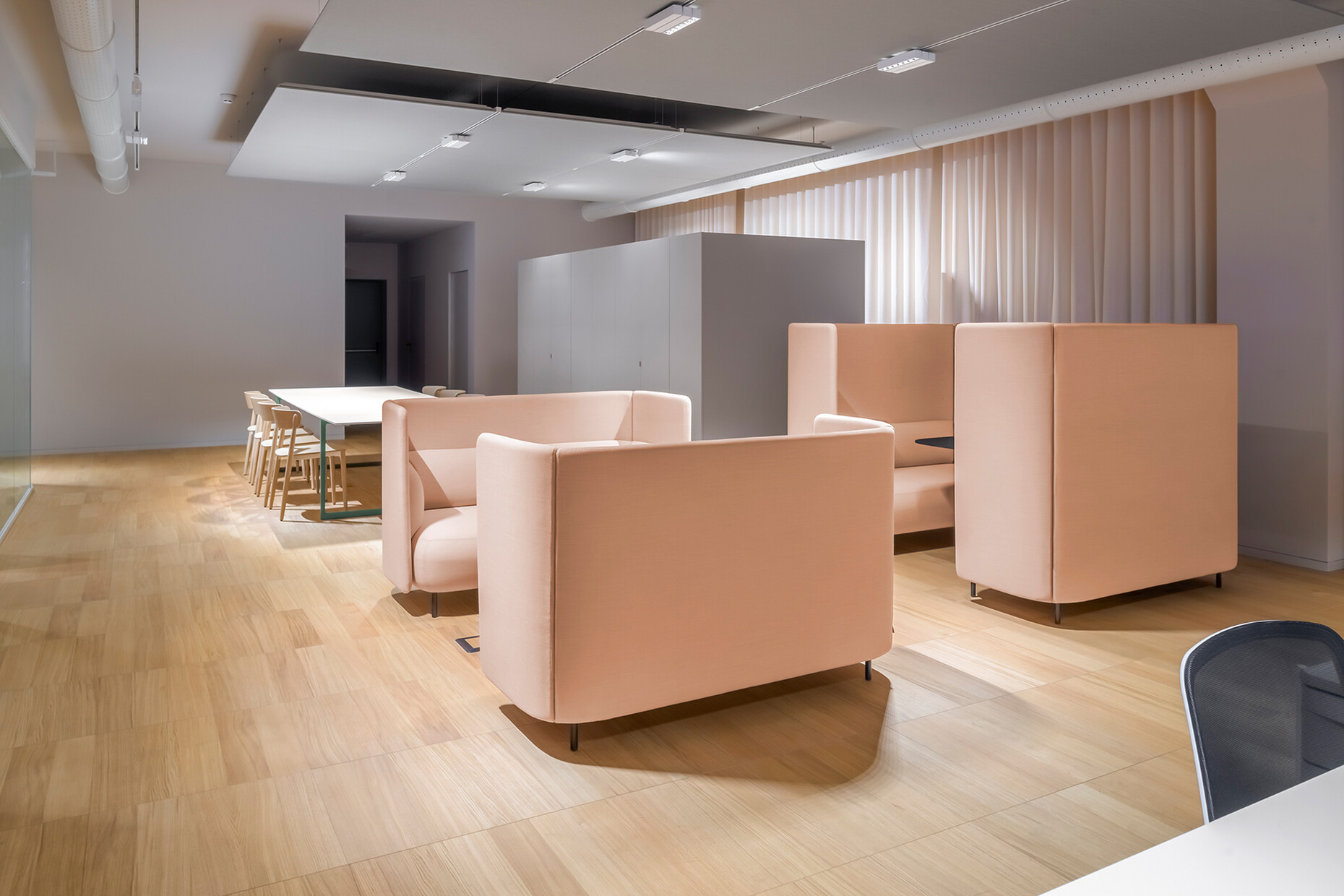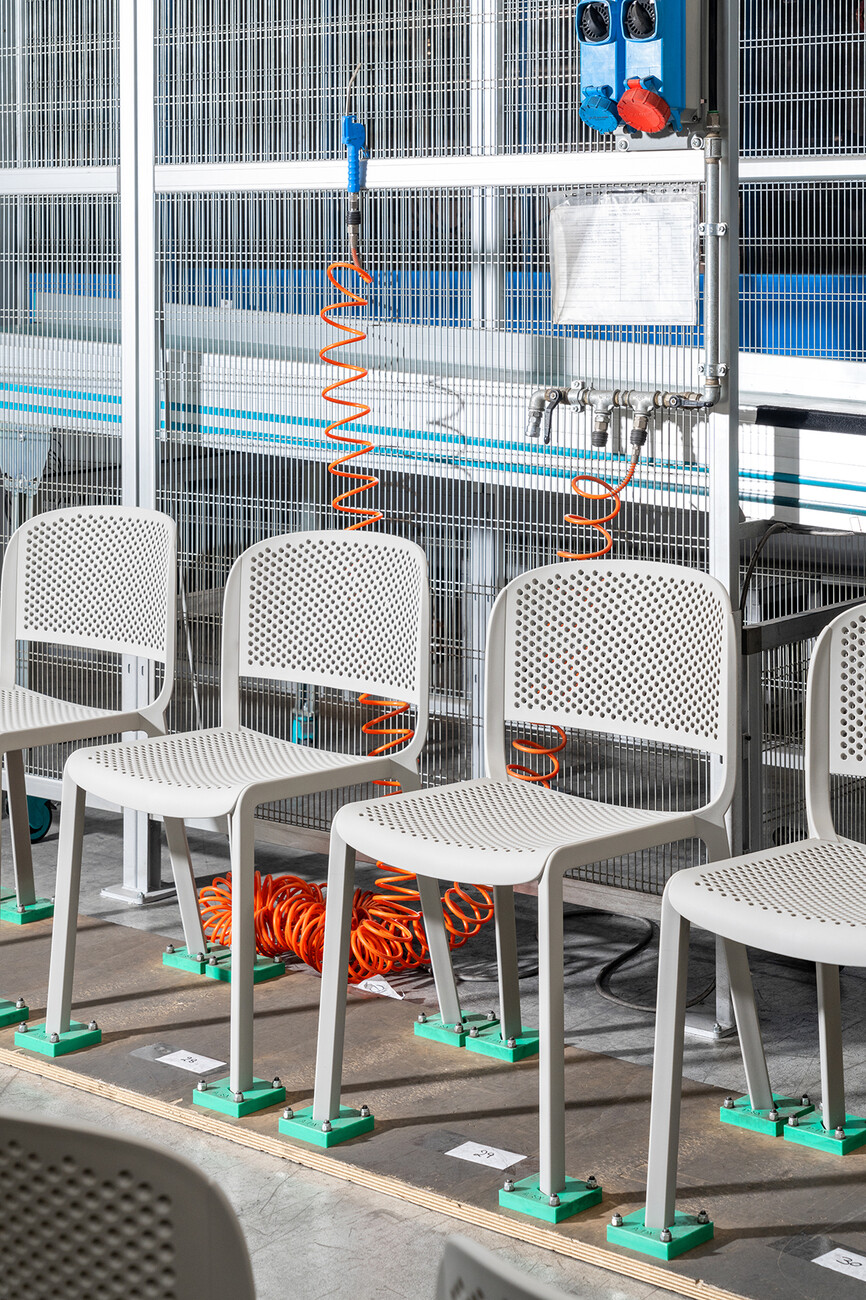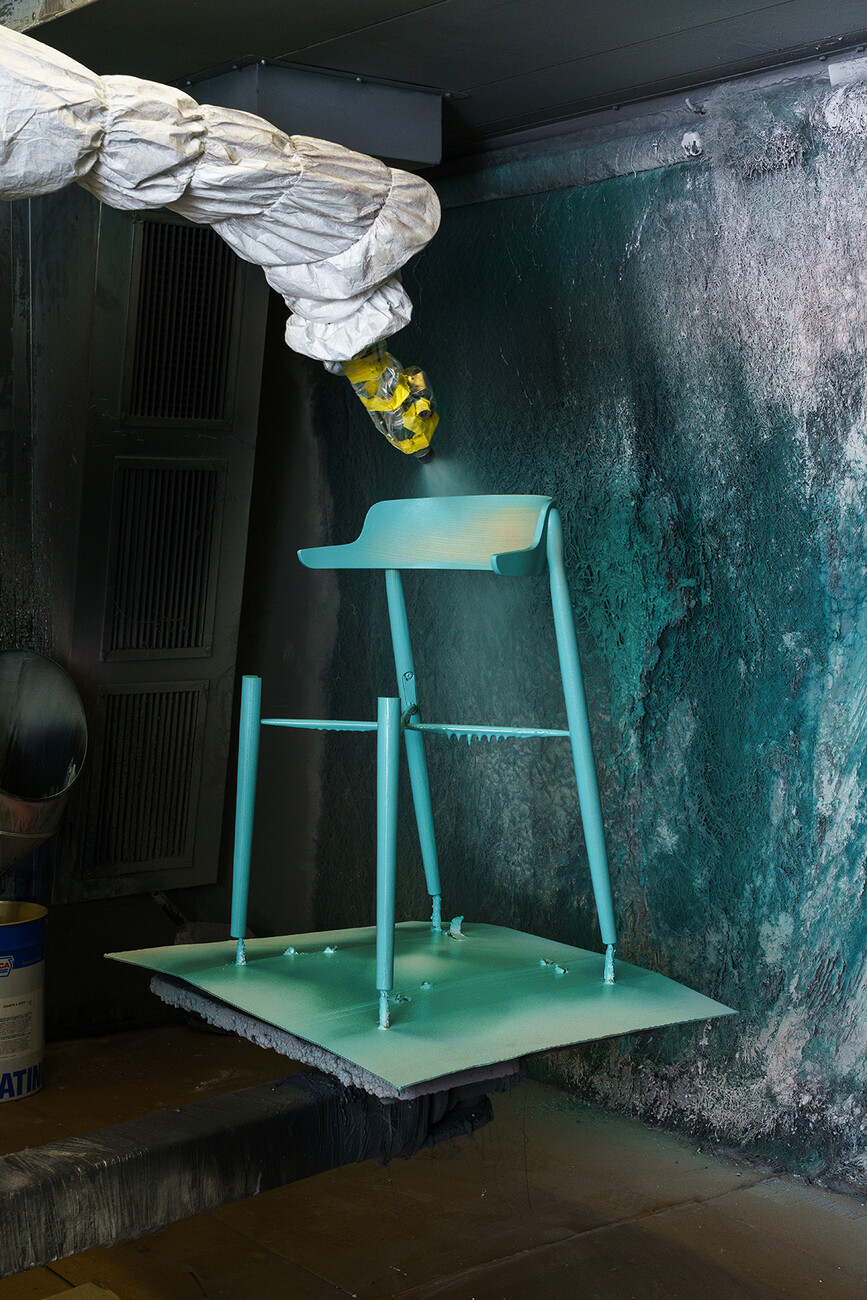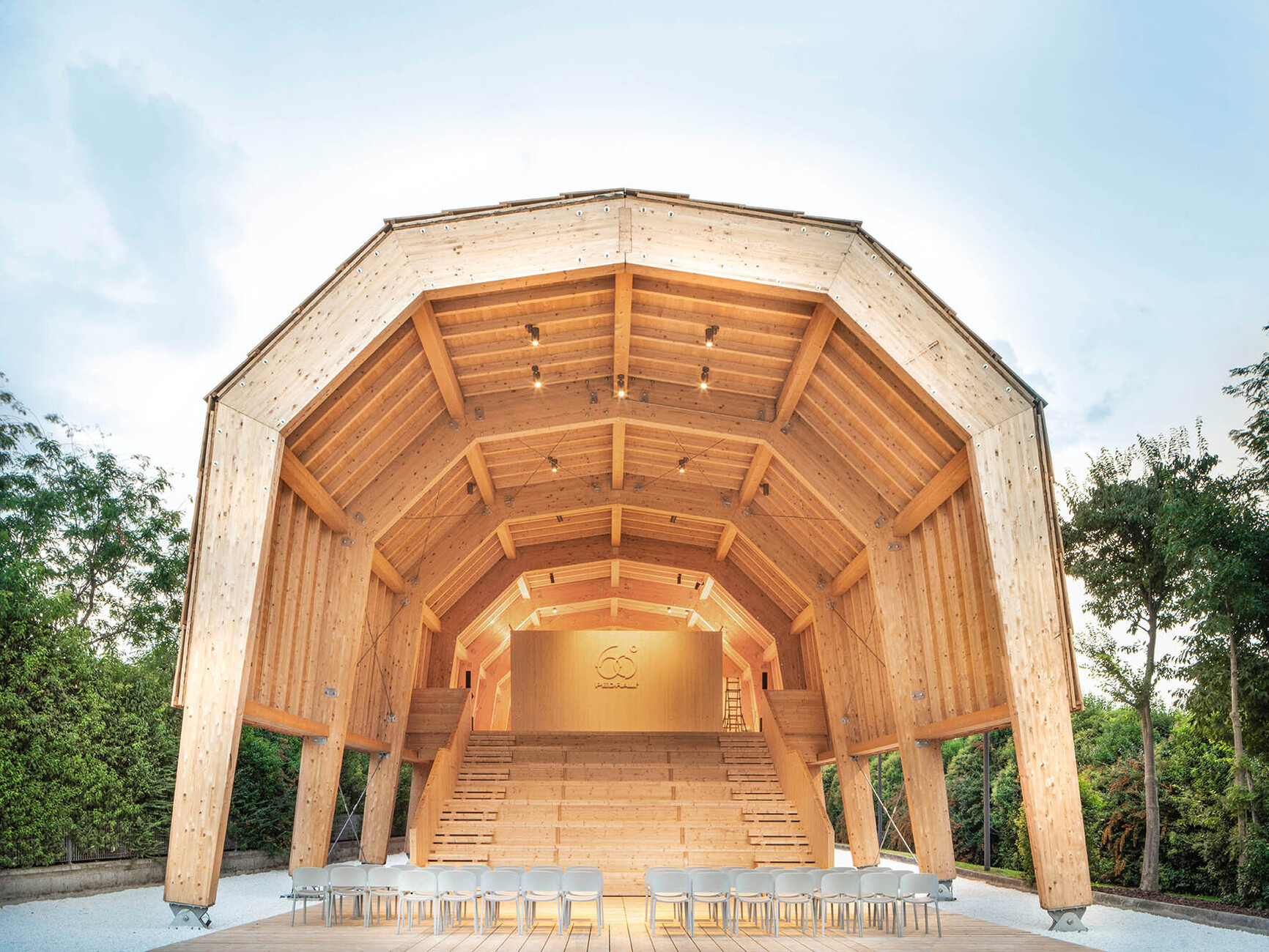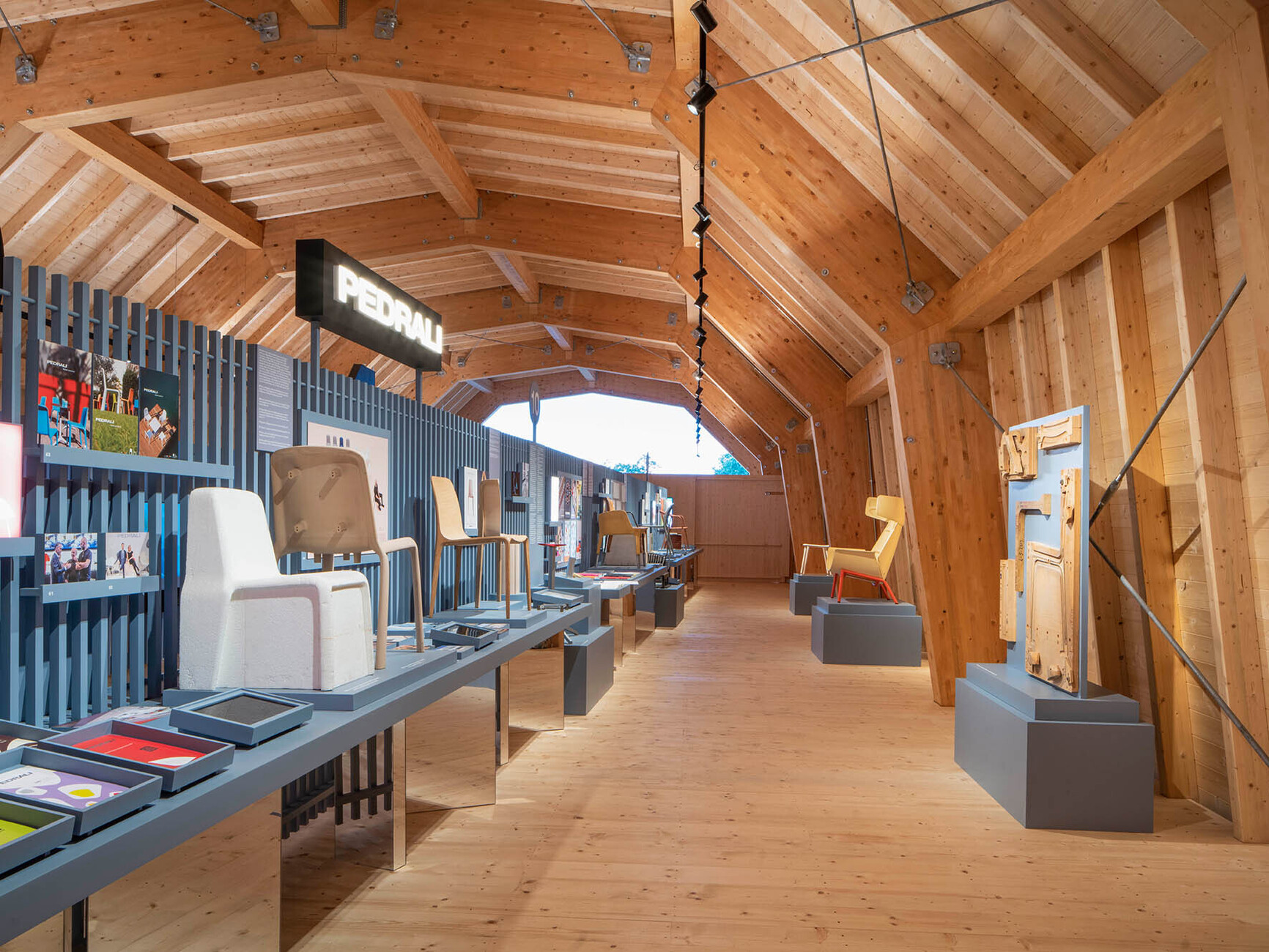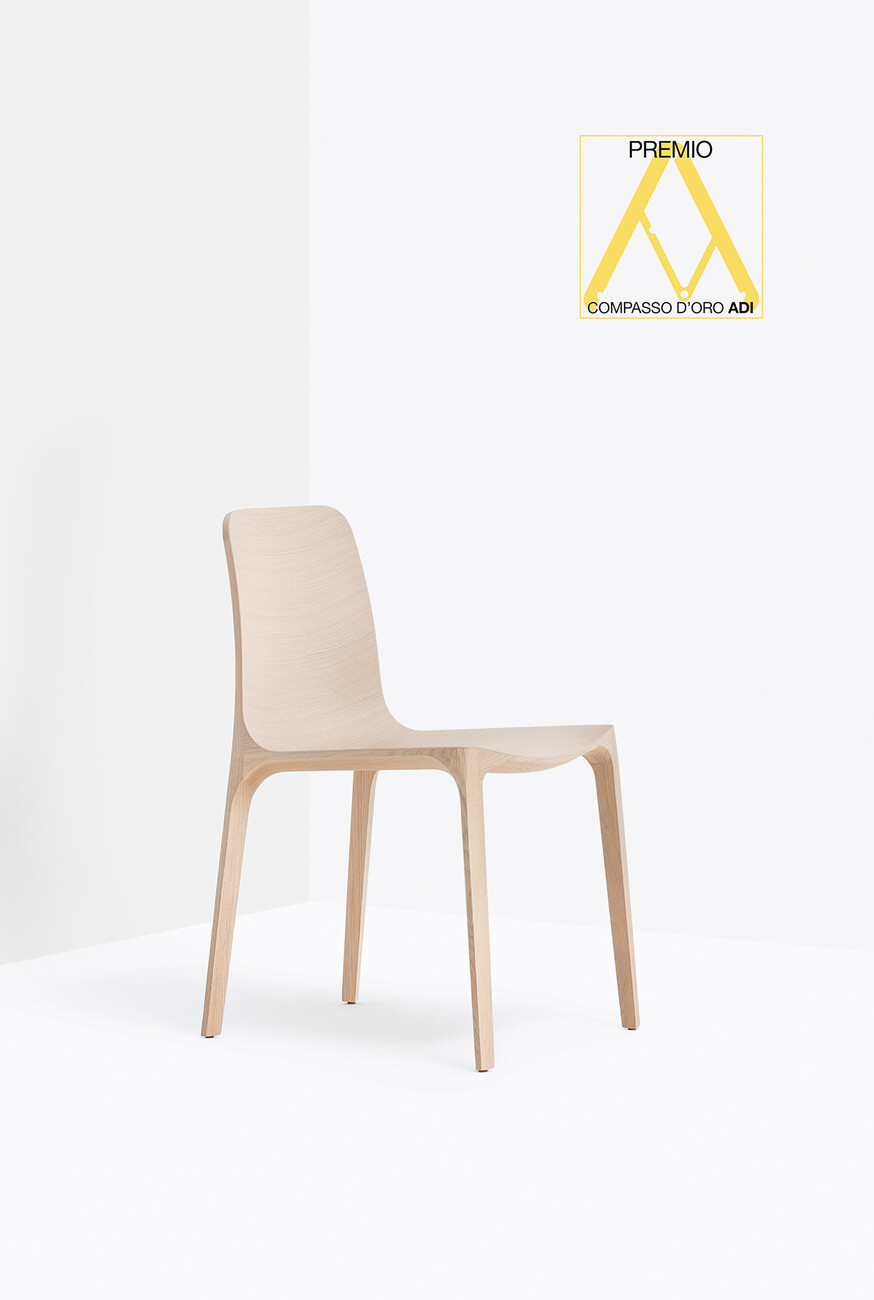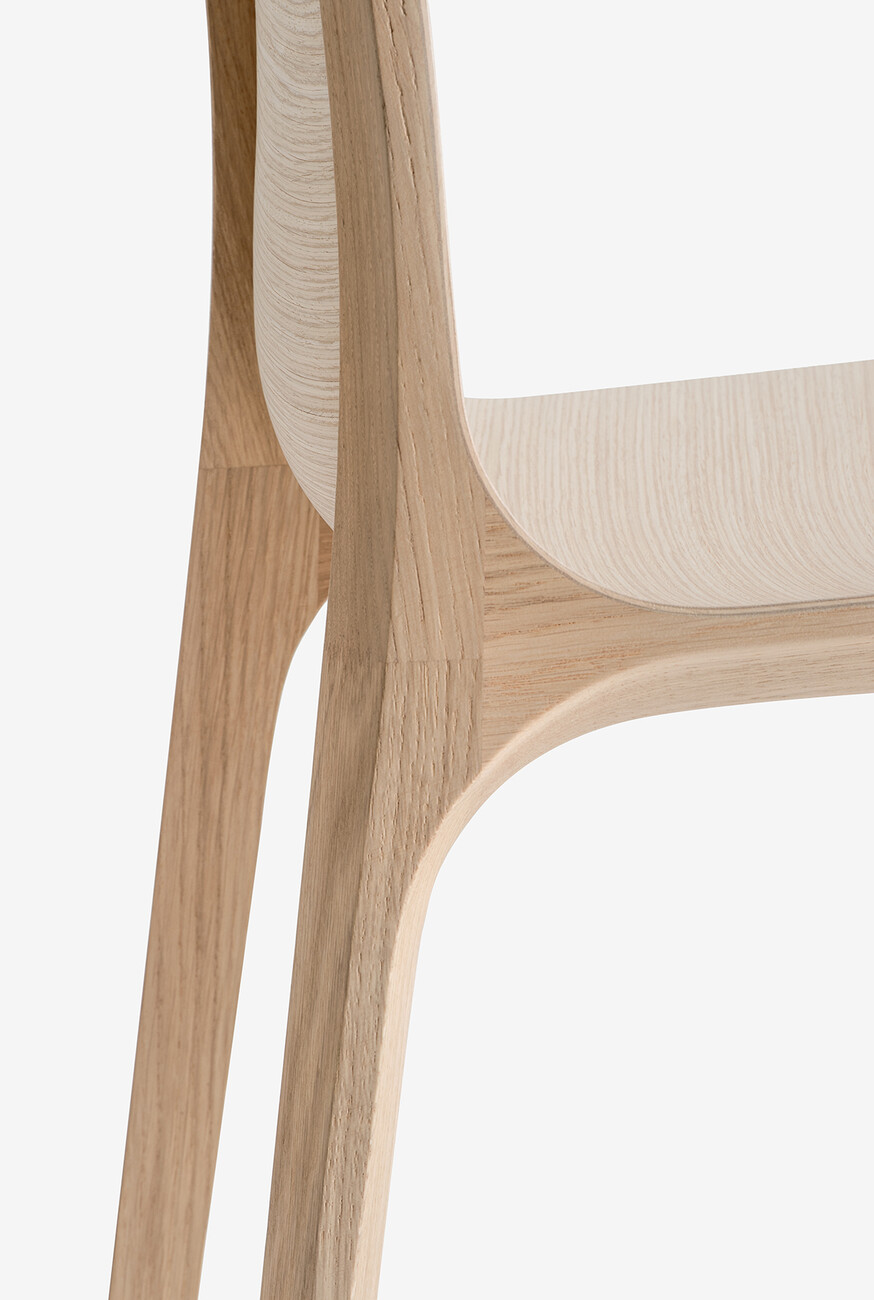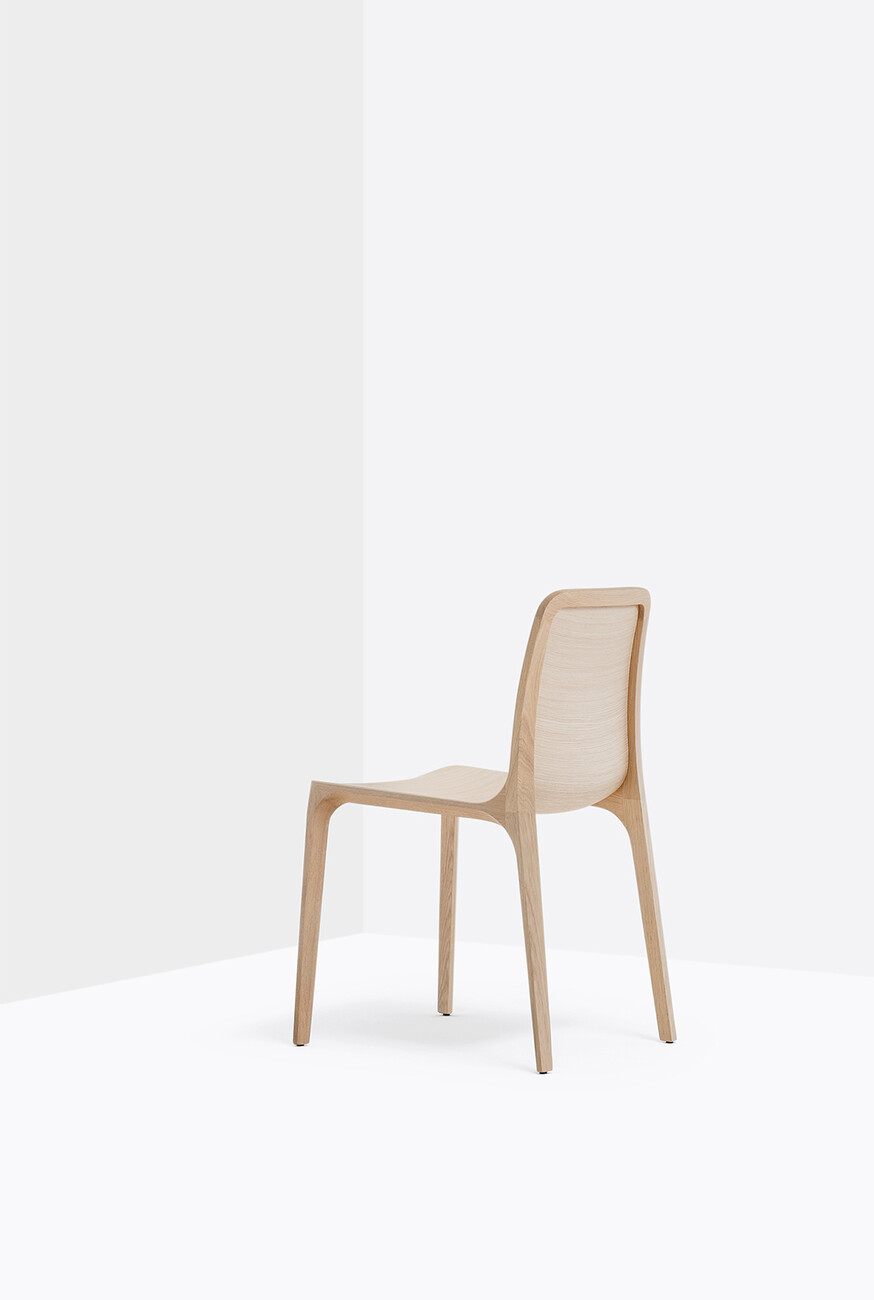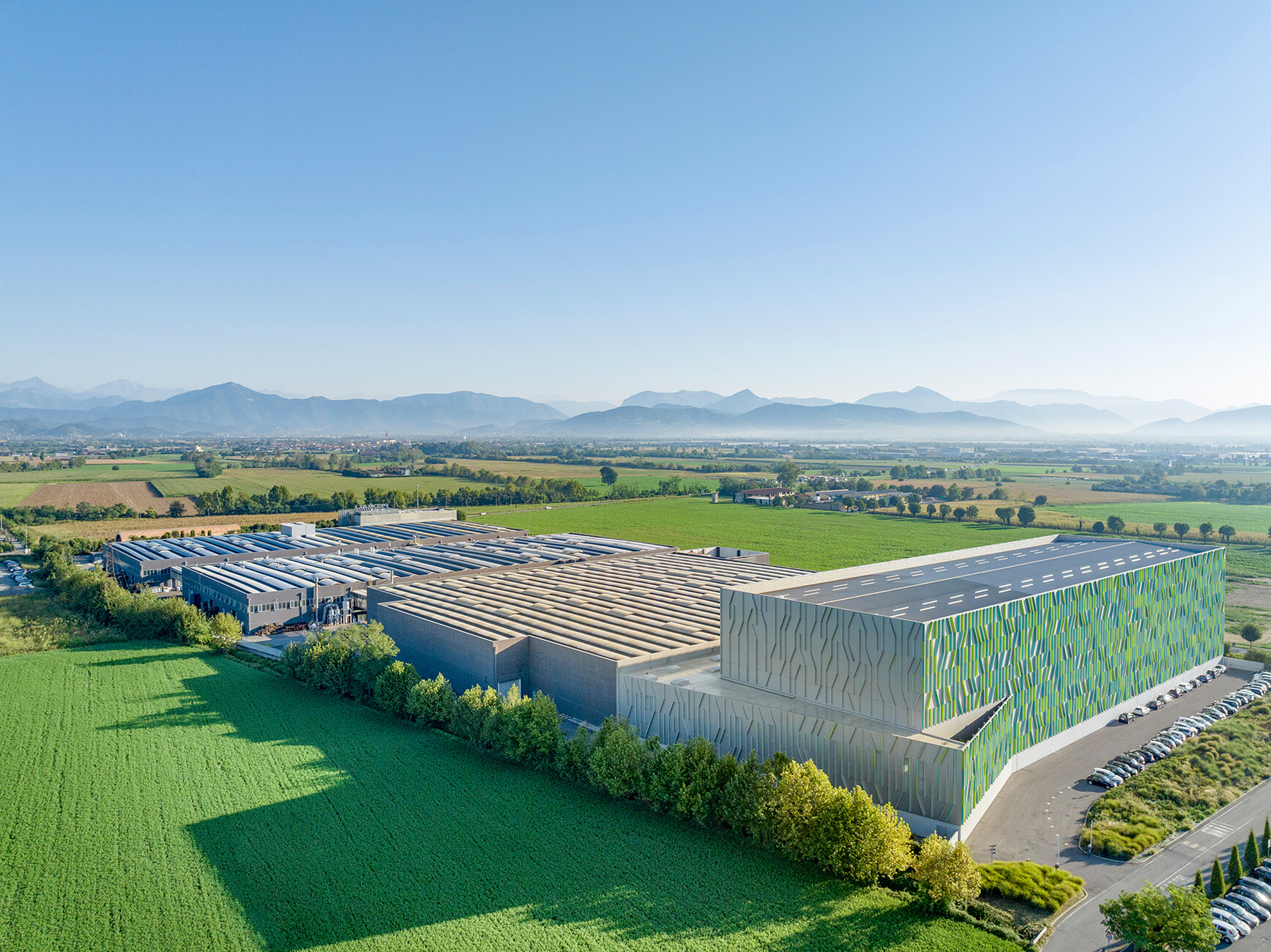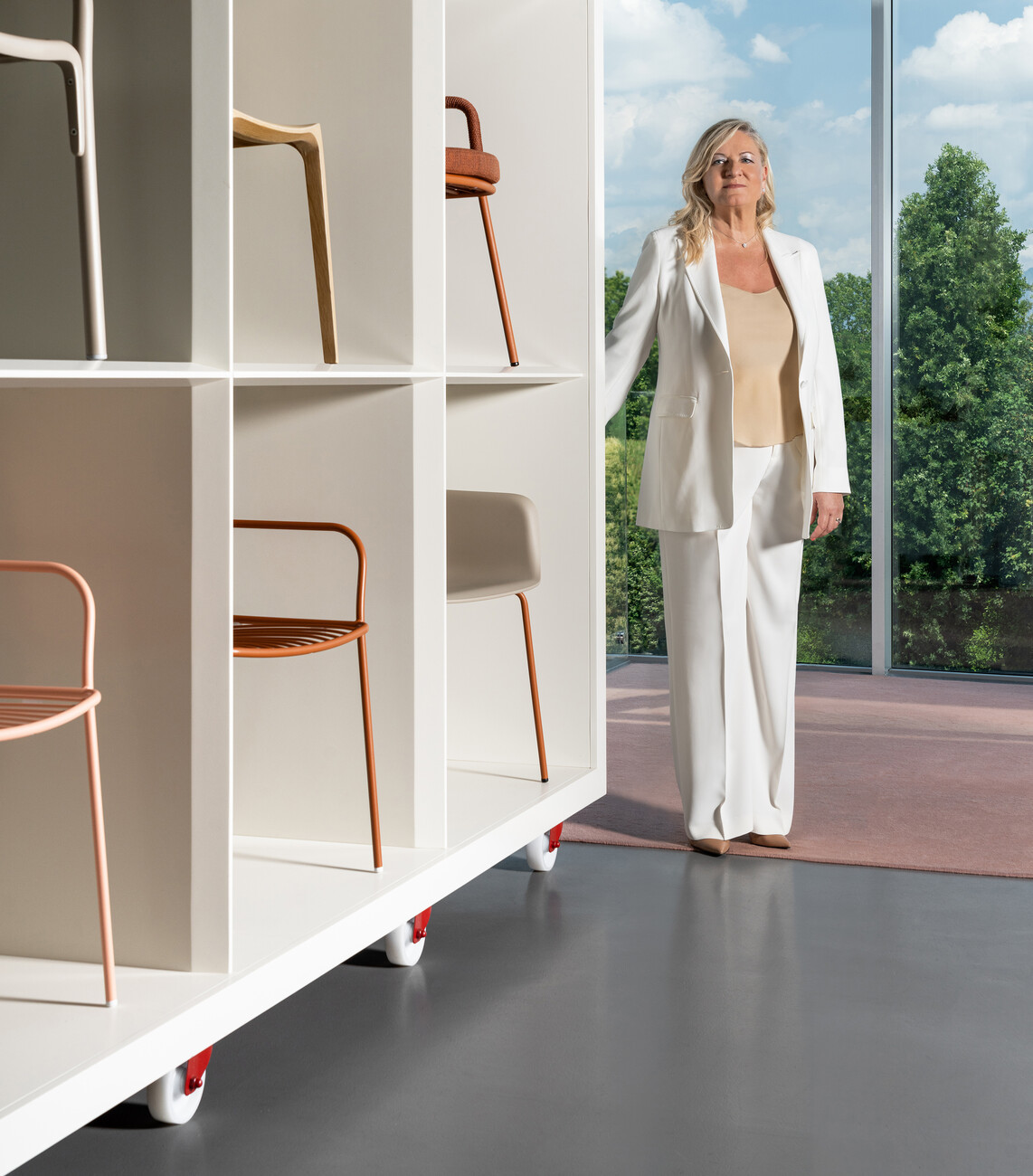STYLEPARK PEDRALI
Real teamwork
Anna Moldenhauer: Part of Pedrali's philosophy is to emphasise people's health and comfort through its furnishing products. How does Pedrali achieve this?
Monica Pedrali: In an era of significant changes, like the one we are experiencing, there is a growing need for spaces that are more fluid and adaptable. Our daily routines are no longer strictly defined, as work can be done from home or in public spaces. In work environments, there is a demand for more areas dedicated to collaboration and fewer individual workstations. Furnishings can contribute by optimizing their functionality, adapting to new lifestyles and workstyles. Bringing beauty and comfort into places where we live can contribute to experiencing quality moments and enhancing the physical and mental well-being of the people who inhabit them. Pedrali has developed more and more upholstered collections in recent years, catering to both the hospitality sector and relaxation moments or work environments. For instance, the "Buddy" collection, born six years ago with an upholstered pouf and chaise-longue, has evolved into a solution for creating sound-absorbing meeting rooms, workstations, or temporary workspaces. Task chairs with adjustable ergonomics to conform to our body shape, designed to promote correct posture for dynamic workstations. For example, the "Polar" chair, a task seat designed by Jorge Pensi, equipped with all the necessary adjustments for maximum ergonomics of our body.
Also, there are height-adjustable desks that allow us to have dynamism in our posture throughout the day, offering dynamic workstations that can be adjusted in height for both sitting and standing work. Greenery also fits into spaces, for instance, "Hevea" is a versatile pot-holder that brings nature indoors. As for moments of relaxation outdoors, we have introduced collections of sofas made from weather-resistant materials but with elegant finishes similar to those designed for indoor use. These include woven elements, coverings in velvet, and bouclé that are no less stylish than indoor finishes. Well-being also comes from the quality of time spent outdoors.
Pedrali recently inaugurated new workspaces at its headquarters in Mornico Al Serio together with the architecture firm Park Associati – the Pedrali Collaborative Space. What are the key points in designing a modern workplace today?
Monica Pedrali: The Pedrali Collaborative Space designed by Park Associati and recently inaugurated at our Headquarters, is conceived as a current, flexible, and dynamic area. From the very name – Pedrali Collaborative Space – it is clear that the guiding principle behind the design was to create a contemporary, dynamic and flexible workspace, developed through the modulation of an innovative layout that focuses on the comfort of the people who use these spaces everyday. The last few years have been rethinking the workspaces with new cross, hybrid areas that move away from the static nature of traditional offices. The modern workspace is no longer just a work area, but a community space that fosters company culture and encourages interaction, sharing, and collaboration. The evolution of work dynamics in recent years has led to a transformation of the workspaces into a place for social interaction, idea generation and community building. Its purpose is to facilitate collaboration, creativity, and learning. Today's modern workplaces must be characterised by fluidity and collaboration, and the selected furnishings play a key role: workstations tailored to needs, configurable meeting rooms, and breakout areas where one can have a moment for relaxation, sharing, and discussion with colleagues.
In our Pedrali Collaborative Space, for example, the smart office is characterised by 32 workstations spread over the entire floor, defined by the practical "Arki-table adjustable desk", which guarantees maximum comfort and ergonomics thanks to its height-adjustable top. The components of office furniture are evolving to achieve better performance, with the primary goal of enhancing people's well-being. Through a mobile application installed on smartphones, users can save personalized settings for the "Arki-table adjustable desk" and set personal wellness goals, allowing for a combination of standing and sitting work. Accompanying the "Arki-table adjustable desk" is "Polar", designed by Jorge Pensi Design Studio, a task chair that ensures maximum customization in terms of ergonomics. Characterised by an organic form "Polar" is designed to adapt to the human body, ensuring the well-being of its users. Another important aspect in creating these spaces is the integration, within work areas, of sound-absorbing panels that allow for the division of space between one workstation and another. Crucial in today's workspaces are well-organized meeting rooms: areas designed for discussion and moments of mutual enrichment. The Pedrali Collaborative Space hosts three well-organized meeting rooms, delimited by glass walls that harmoniously allow for dialogue while maintaining the privacy required by the context.
To promote social interaction, the demand for breakout areas has grown, providing spaces for relaxation or breaks with colleagues. Our "Buddyhub" by Busetti Garuti Redaelli, for instance, is a functional and efficient furnishing element, characterised by a wrap-around, sound absorbing panel, available in two heights, that envelops the seat in a sort of enclosed niche. "Buddyhub" is available as an armchair or sofa, and can be used as a quiet, sound-proofed temporary workstation. It is created to meet the needs of open spaces typical of a contemporary working environment. It is also possible to place two units opposite each other and to join them by means of a panel, thus creating a four-seat box suitable for an informal meeting, a phone booth or a break out area. The functionality of this element is further enhanced by the possibility of adding sockets both to the armchair and box versions, so as to be able to connect a charger. In this case, it is also possible to provide for a screen holder, a peninsula table or a shelf. The selection of materials plays a crucial role in ensuring the overall quality of a project. It's essential to recognize how materials directly impact various quality aspects, such as durability, reliability, and performance.
All manufacturing processes, from design and materials to production, logistics and dismantling, are sustainably thought through and constantly optimized. What goals has Pedrali currently set itself in the field of sustainability?
Monica Pedrali: The commitment to sustainability is a fundamental aspect for us, a cornerstone where we strive for continuous improvement every year. We firmly believe that a product cannot be sustainable if it is produced in a factory that is not sustainable and safe. Therefore, in 2023, we obtained the UNI ISO 45001:2018 certification for occupational safety, health and governance management system. Also, in the course of 2023, we received the results of the Carbon Footprint study for 2021. Pedrali has been measuring this for five years now. In 2021 we recorded a 12 percent reduction in CO2 equivalent compared to 2019, equal to approximately 4430 tons less emissions of CO2 equivalent. This was possible thanks to a series of concrete improvements. For example, we have installed over 6,000 square metres of photovoltaic panels at our factories, producing a total amount of 1.2 Megawatt of energy during periods of high light intensity, able to cover the energy needs of the production site in Mornico al Serio. We have reduced our energy consumption during the cold season by recovering the hot water produced by the plastic moulding processes and ducting it to heat the other production departments.
Likewise, during the warmer season, a system composed of cooling towers lowers the temperature of the mould water, reducing the consumption of electrical energy required to run the cooling systems. Another improvement this year was the conversion of the factory's lighting system to LED. We have also obtained the ReMade in Italy® certification, which guarantees the chain of custody in the production of chairs made from recycled polypropylene. We use 50 percent of post-consumer recycled material and 50 percent from industrial waste, in a circular economy perspective. These chairs are made in Italy using zero-kilometer waste. Being sustainable is a priority for us, and as manufacturers, we feel a significant responsibility. 80 percent of a product's sustainability is already defined in the design phase. Pedrali furnishings are designed to be disassembled and produced through processes aimed at limiting consumption. Moreover, creating durable products, both aesthetically and in terms of resistance, is the key element to ensuring sustainability. We will continue in this direction, delving into the technical specifications of each product, highlighting aspects that can contribute to earning credits for achieving LEED building certifications, which are increasingly sought after. The most important commitment will be to disseminate all this information to better inform consumers about the advantages of purchasing sustainable and long-lasting furniture, which can be maintained and repaired over its lifespan and, why not, passed down from generation to generation.
Reflecting the roots of your own company and getting back to nature are movements that have been recognisable in the development of Pedrali in recent months, including in the design of the products. Why is this kind of awareness important to you?
Monica Pedrali: #PedraliBacktoNature was the title of our booth at the Salone del Mobile 2023. This is how we wanted to start the celebration of Pedrali's 60th anniversary, and it is precisely with wrought iron garden furniture that my father Mario started in his workshop in 1963. Over the years, artisanal wrought iron work has evolved with more industrialized processes. Various materials have been added, such as die-cast aluminum and plastics. In the 1980s, Pedrali specialized in producing furniture for indoor spaces, incorporating wooden and upholstered seating. For Pedrali's 50th anniversary, CMP Design introduced us to the Nolita chair, reminiscent of the metal garden chairs from our early years. Two years later, thanks to the use of a new technology for three-dimensionally bending the tube, it was launched on the market. Today, it's a complete collection and an iconic product of Pedrali. Perhaps the market expected this from us – to return back to our origins.
Next, "Tribeca" and "Panarea", still designed by CMP Design, where craftsmanship once again took the lead. In this case, it was no longer the craftsmanship of iron, which became automated, but rather the manual weaving of rope – a traditional Italian craft to preserve. Then there's "Reva Cocoon", a collection of outdoor sofas that are super cozy and modular, designed by Patrick Jouin. More recently, "Narì", designed by Andrea Pedrali, Giuseppe's son, dedicated to his grandfather for the 60th anniversary. In the 1960s, during the economic boom, garden furniture represented leisure time, Sunday outings, and the joy of life. And 60 years later, in a post-pandemic era, we notice a renewed attention to the quality of outdoor life and high-quality furnishings. This time, not only for homes and public spaces but also for work environments.
This year Pedrali is celebrating its 60th anniversary – with, for example, a wooden pavilion designed by Michele De Lucchi, the founder of AMDL CIRCLE. What do you want to visualise with this project?
Monica Pedrali: The Pedrali Pavilion, designed by AMDL CIRCLE and Michele De Lucchi, was built at the Pedrali Headquarters in Mornico al Serio to host the temporary exhibition, “Pedrali60, we design a better future” by Luca Molinari Studio, dedicated to Pedrali's 60th Anniversary. It was inaugurated in September and hosted over 3000 visitors from more than 60 countries, including our partners, clients, architects, suppliers, and collaborators who contributed to the history of two generations: that of our founder, our father Mario, and that of mine and Giuseppe's. The Pavilion was also open to the public and hosted a schedule of meetings, design talks, also in conjunction with Bergamo and Brescia 2023 Italian Capital of Culture, where the culture of entrepreneurship, design, and furniture was presented as case studies to the public and the new generations. Meetings with schools, design universities, high-level training courses for 4.0 Industry, economics, and communication, meetings with architects' associations, art museum foundations, and cultural associations within the territory.
I must say that this test worked: now the temporary pavilion will become permanent and will be transformed into a space dedicated precisely to these types of initiatives. The “Pavilion with Legs”, as described by Michele De Lucchi, on two floors, can now be transformed into a multifunctional environment for organizing meetings, temporary exhibitions, and installations. A place to bring people together and generate new ideas, this is the mark that will remain for this important step.
In the pavilion, the exhibition "Pedrali60, we design a better future" by Luca Molinari Studio allows visitors to trace the multifaceted success story of the company. Is there a milestone that you are particularly proud of?
Monica Pedrali: Our ability to innovate while firmly holding onto our roots, entering new sectors: from outdoor to hospitality, to workspaces. Not limiting ourselves to working with a single material but experimenting with different materials: from wrought iron to aluminum, steel, plastics, upholstered materials, and wood. Each time has been a challenge, experimenting with new machinery, new technologies, trying to do things differently from others, not taking anything for granted. Believing in investment projects, even in the medium term, with courage and confidence in the future, that's what our father taught us.
Pedrali has always worked with designers as equals, believed in their creative ideas and also invested in the further development of production to realise them. One result of this spirit of cooperation is the "Frida" chair by Odo Fioravanti, which was awarded the renowned Compasso d'Oro ADI. Where does this openness in Pedrali's way of working come from?
Monica Pedrali: We had met Odo Fioravanti in 2007, when he presented us with the Snow chair, which had won the first Young & Design award at the Salone del Mobile 2008. A few months later, we entrusted him with a project to develop a lightweight oak chair, using the newly introduced three-dimensional plywood on the market. Pedrali had only started producing wooden chairs in 2005, and the challenge was to make the most of solid wood in a sustainable manner. Odo Fioravanti accepted this challenge, even though he had no experience with wood, and was supported by our prototype manager, Gianni Bertocco, from our factory in Manzano. He learned from him how to shape the chair. The result was the selection and winning of the XXII Compasso d’Oro ADI 2011 for its "simple sculptural beauty”. It often happens that new products result from the work, experience, and know-how of various individuals: external designers, our R&D department, our prototype developers, our technicians, and our material or technology suppliers.
The factory is made up of many people who contribute their ingenuity and ideas every day to create innovation. This is typical of the Italian way of doing things in the furniture sector. We believe that innovative products can only arise through synergy and collaboration among individuals. Giuseppe engages daily with designers; being firsthand knowledgeable about product realization, he sensitizes designers towards optimizing raw materials, manufacturing processes, and resources. About 80 percent of a product's sustainability is determined during the design phase. On the other hand, our collaboration with designers has allowed us to develop products that age more gracefully, with a more international appeal, and are worthy of decade-long investments. This, coupled with Pedrali's openness to young talent (one of the teachings our father, Mario, even if it's not always the easiest path), brings us great satisfaction. In the case of Odo Fioravanti, our collaboration began swiftly and has been fruitful for 16 years. We've also learned a great deal from him!
One of your guiding principles is 'think global, act local' – in other words, all Pedrali products are manufactured in Italy, and also mainly in your own factories. Why has this concept proved to be successful for you?
Monica Pedrali: Pedrali manufactures all its products within its two factories in Bergamo and Udine. For us, "Made in Italy" means "Made in Pedrali." Our challenge has always been to grasp the essence of Italian craftsmanship – a blend of tradition, expertise, and skills that are challenging to replicate elsewhere – while pursuing a path of continuous innovation. This is what our father, Mario, taught us: to maintain production in Italy and remain competitive, it was essential to innovate not only in the products, but also in the production facilities, adopting interconnected machinery and a fully automated warehouse. The automation and digitalization of the factory have allowed the replacement of more strenuous manual processes and the requalification of existing employees, as well as the addition of new ones.
Today, we have more than 350 collaborators, particularly employed in activities that create value, such as quality control, waste reduction, resource optimization, and customer service. These individuals share passion, enthusiasm, and dedication, collectively contributing to a path of continuous renewal while remaining firmly rooted in our values and heritage. Nearly 20 years ago, we adopted Lean Production, eliminating warehouse stocks and producing only what was strictly necessary for each project. We expanded our range of finishes, reduced delivery times, which is exactly what today's market demands.
Pedrali is internationally orientated and exhibits at trade fairs and events worldwide, which is also visible in your showroom in Chicago. In what way has this open approach changed your work in recent years?
Monica Pedrali: The first trade fairs my father attended date back to the early 60s, then Milan, Cologne and other European capitals. Over these 60 years, Pedrali has attended 340 fairs, particularly increasing its presence from the 1990s when production capacity and our collections grew. Trade fairs are an excellent opportunity to introduce our brand to new markets, showcase innovations in established markets, and engage with industry professionals. Thanks to these fairs, we've been exporting our products since the 1970s, establishing a presence in over 120 countries today. Today, especially after the interruption of trade shows due to the pandemic, the scenario has changed. There aren't as many opportunities to address a truly international audience.
The Salone del Mobile, where we have been exhibiting since the 1980s, remains the most important event for us, where we showcase our new collections. Moreover, in the last two years, there has been a further transformation in habits and a reduction in travelers from some countries. This situation led us to intensify visits directly to our factories to introduce novelties and deepen the quality and sustainability of our products. The relationship with the A&D community is also crucial because it allows us to explain the quality and versatility of our products, which are highly appreciated and integrated into prestigious contexts. In the USA, a rapidly growing market for us, where our quality and design are highly valued, we've had a showroom in Chicago at The Mart for 4 years now. It spans an area of 300 square meters where we meet architects, and once a year, the NeoCon office sector fair takes place.
Every year you present a new collection at the Salone del Mobile, meaning the company always works at a very fast pace. Why is that important to you?
Monica Pedrali: We have been present and exhibiting at the Salone del Mobile.Milano since 1988, and it remains the most important international event in the furniture sector. The Salone del Mobile represents a goal towards which we all work; it means setting a deadline by which all ongoing projects must converge. Every year, we introduce about ten new, original products, including brand new collections and expansions of existing families, designed by different designers, at least one of whom is a new collaboration for Pedrali. The pace at which we present new products is the result of Giuseppe's dynamism and the work and passion of many people. Certainly, with the designers we have been working with for years, the process is faster because the collaboration is already tried and tested, and there is a lot of harmony. They are always enthusiastic about presenting new ideas to continue our collaboration. Alongside them, we also select spontaneous projects that other designers present to us, or it is us who provide a brief to a new designer. In these cases, the process takes a little longer. The presentation of innovative products is made possible, in part thanks to the short supply chain. Having direct contact with machinery suppliers and materials sometimes allows us to be among the first to experiment with the products. The new technologies adopted within the technical office enable us to use modeling and simulation programs, AI, and this helps reduce the time-to-market, from when an idea is born to when it is presented in the market.
It has been possible to maintain this pace over the years because the market has been able to quickly embrace and promote products from previous collections, which reflects the trust in our brand. The products are the result of the work of many people, and being able to present them in time for the Salone del Mobile is the motivation that drives us to always give our best. Participating in the Salone del Mobile is not just about advancing new product projects, but also the project of the booth, the choice of new finishes, the magazine, videos, communication; it's like a puzzle that comes together at a certain point. And it's magical how all this work gets done on time, maintaining high quality and attention to detail. Every year, we commission an architecture studio to design the booth setup. We ask for a stand that is also the stage for the memorable presentation of new products and a source of inspiration for architects, and last but not least, a welcoming place to meet people. There's little time left until the next Salone del Mobile.Milano 2024, for which DWA Design Studio will design the new booth.
Together with your brother, you are the second generation to lead the company founded by your father. What would you say is your life's mission for Pedrali?
Monica Pedrali: In my role as Sales Director, I aimed to go beyond managing the sales network and trade fairs. I believe that engaging with architects and interior designers is strategic in adding value to the quality of our products. This approach allowed us to keep production in Italy while understanding market needs and anticipating trends. Giuseppe, who coordinates product development alongside product designers and the R&D department, always involved me in strategic meetings with designers. It has been a mutual enrichment to work with them. Today, I can say that my most important mission has been to enhance the role of all the stakeholders involved in the sector: the product designers, our partners in the field as agents, furniture retailers and the architects. Over the last 25 years, Pedrali has shifted from producing furniture for stock to working on projects, manufacturing tailor-made products based on actual needs. The factory not only adapted to this change but also proved to be advantageous. And the result is evident in the projects around the world where Pedrali furniture is present. It has been a real teamwork, where everyone has enhanced their skills, and no one has been excluded, a true “Pedrali community”.
